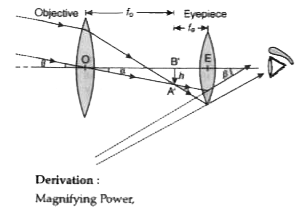(a) Draw a neat labelled ray diagram showing the image formation of a distant object by a refracting telescope.
Deduce the expression for its magnifying power when the final image is formed at infinity.
(b) The sum of focal lengths of the two lenses of a refracting telescope is 105 cm. The focal length of one lens is 20 times that of the other. Determine the total magnification of the telescope when the final image is formed at infinity. Solution in Kannada
(i) 
Derivation :
Magnifying Power,
M=tanβtanα≅βα
Final image is formed at infinity when the image A.B. is formed by the objective lens at the focus of the eye piece.
m=hfe×f0h
=f0fe
(b) Given
f0+fe=105,f0=20fe
20fe+fe=105
fe=10521=5cm
f0=20×5=100cm
∴ Magnification, m=f0fe=1005=20
Topper's Solved these Questions
- BOOK - OSWAAL PUBLICATIONCHAPTER - RAY OPTICS AND OPTICAL INSTRUMENTSEXERCISE - TOPIC-3(Numerical Problems)3videos
RAY OPTICS AND OPTICAL INSTRUMENTS
- BOOK - OSWAAL PUBLICATIONCHAPTER - RAY OPTICS AND OPTICAL INSTRUMENTSEXERCISE - TOPIC-3(SHORT ANSWER TYPE QUESTIONS-II)2videos
RAY OPTICS AND OPTICAL INSTRUMENTS
- BOOK - OSWAAL PUBLICATIONCHAPTER - NUCLEIEXERCISE - TOPIC -2 (Numerical Problems)3videos
NUCLEI
- BOOK - OSWAAL PUBLICATIONCHAPTER - Sample Paper 1EXERCISE - Exercise36videos
Sample Paper 1
Similar Questions
The total magnification produced by a compound microscope is 20. The magnification produced by the eye piece is 5. The microscope is focussed on a certain object. The distance between the objective and eyepiece is observed to be 14cm.
If the least distance of distinct vision is 20cm, calculate the focal length of the objective and the eye piece.02:01View SolutionDraw a labelled ray diagram showing the formation of a final image by a compound microscope at the least distance of distinct vision.
01:36View SolutionThe half life of 38Sr90 isotope is 28 years. What is the rate of disintegration of 15 mg of this isotope? (Given Avogadro No =6.023×1023)
02:44View SolutionCharges of 10μC and 15μC are separated by a certain distance. Which charge repels the other with a greater force?
04:22View SolutionA small telescope has an objective lens of focal length 140cm and eye piece of focal length 5.0cm. What is the magnifying power of telescope for viewing distant objects when
(a) the telescope is in normal adjustment (i.e. when the image is at infinity)
(b) the final image is formed at the least distance of distinct vision (25cm).02:26View SolutionA small telescope has an objective lens of focal length 140 cm and an eyepiece of focal length 5.0 cm. what is the magnifying power of the telescope for viewing distant objects when
(a) the telescope is in normal adjustment (i.e, when the final image is at infinity ),
(b) The final image is formed at the least distance of distinct vision (25 cm )04:02View SolutionA telescope objective lens has a focal length of 100cm . When the final image is formed at the least distance of distinct vision, the distance between the lenses is 105cm. Calculate the focal length of eye piece and magnifying power of telescope.
02:17View SolutionDraw a neat labelled diagram of image formed in a refracting telescope. Give the expression for magnification of an object, for an image formed at infinity.
View SolutionA small telescope has an objective lens of focal length 140 cm and eyepiece of focal length 5.0 cm. What is the megniftying power of the telescope for viewing distant objects when
(a) the telescope is in normal adjustment (i.e, when the final image is at infinity )
(b) the final image is formed at the least distance of distinct vision (25cm) ?01:54View SolutionThe sum of focal lengths of the two lenses of a refracting telescope is 105 cm. The focal length of one lens is 20 times that of the other. Determine the total magnification of the telescope when the final image is formed at infinity.
01:58View SolutionA small telescope has an objective lens of focal length 140cm and an eyepiece of focal length 5.0cm. What is the magnifying power of the telescope for viewing distant objects when
(a) the telescope is in normal adjustment (i.e., when the final image is at infinity)?
(b) the final image is formed at the least distance of distinct vision (25cm)?View SolutionA small telescope has an objective lens of focal length 140cm and an eyepiece of focal length 5.0cm. What is the magnifying power of the telescope for viewing distant objects when
(a) the telescope is in normal adjustment (i.e., when the final image is at infinity)?
(b) the final image is formed at the least distance of distinct vision (25cm)?03:23View SolutionA small telescope has an objective lens of focal length 140cm and an eyepiece of focal length 5.0cm. What is the magnifying power of the telescope for viewing distant objects when
(a) the telescope is in normal adjustment (i.e., when the final image is at infinity)?
(b) the final image is formed at the least distance of distinct vision (25cm)?02:08View SolutionA small telescope has an objective lens of focal length 140cm and an eyepiece of focal length 5.0cm. What is the magnifying power of the telescope for viewing distant objects when
(a) the telescope is in normal adjustment (i.e., when the final image is at infinity)?
(b) the final image is formed at the least distance of distinct vision (25cm)?03:00View SolutionA small telescope has an objective lens of focal length 140 cm and an eyepiece of focal length 5.0 cm. What is the magnifying power of the telescope for viewing distant objects when
(a) the telescope is in normal adjustment (i.e., when the final image is at infinity) ?
(b) the final image is formed at the least distance of distinct vision (25 cm) ?04:58View Solution

